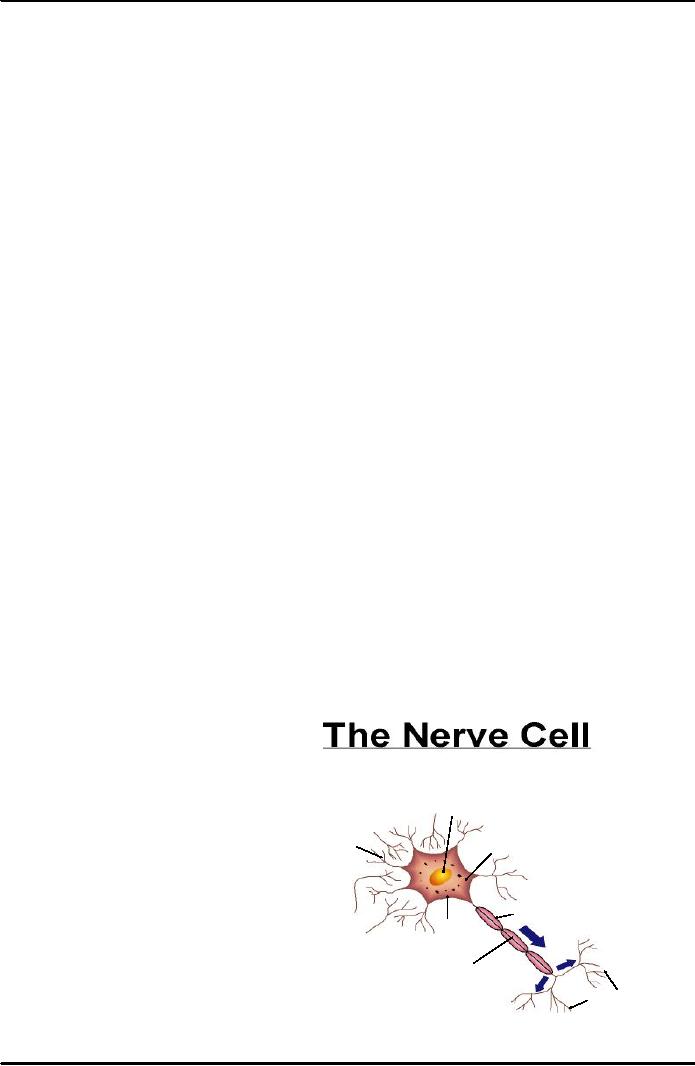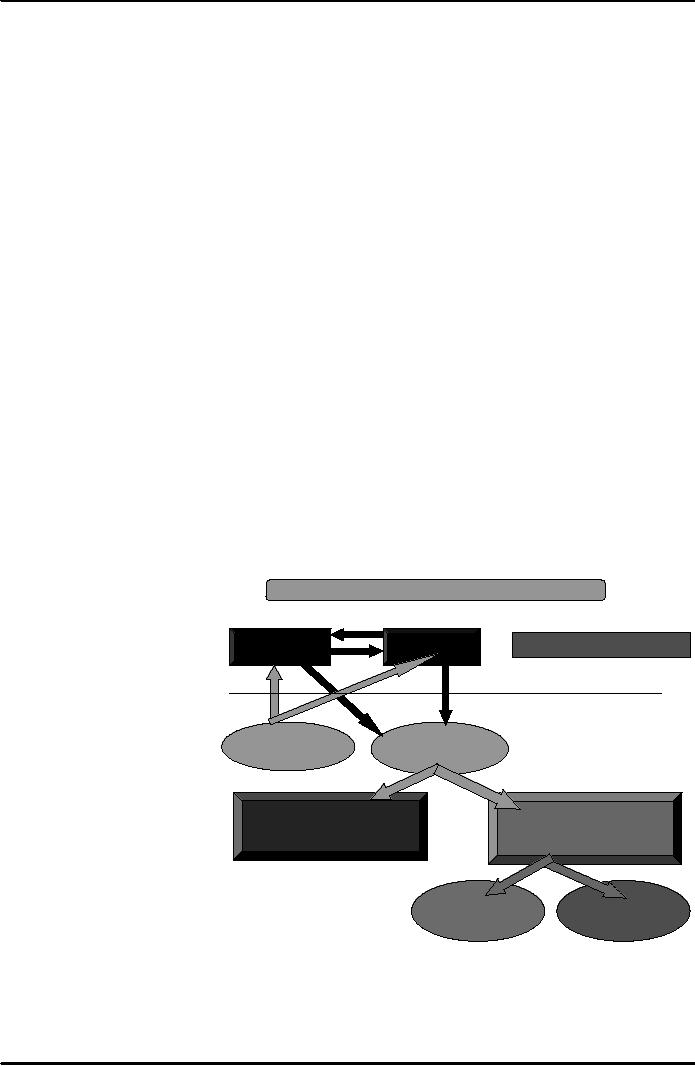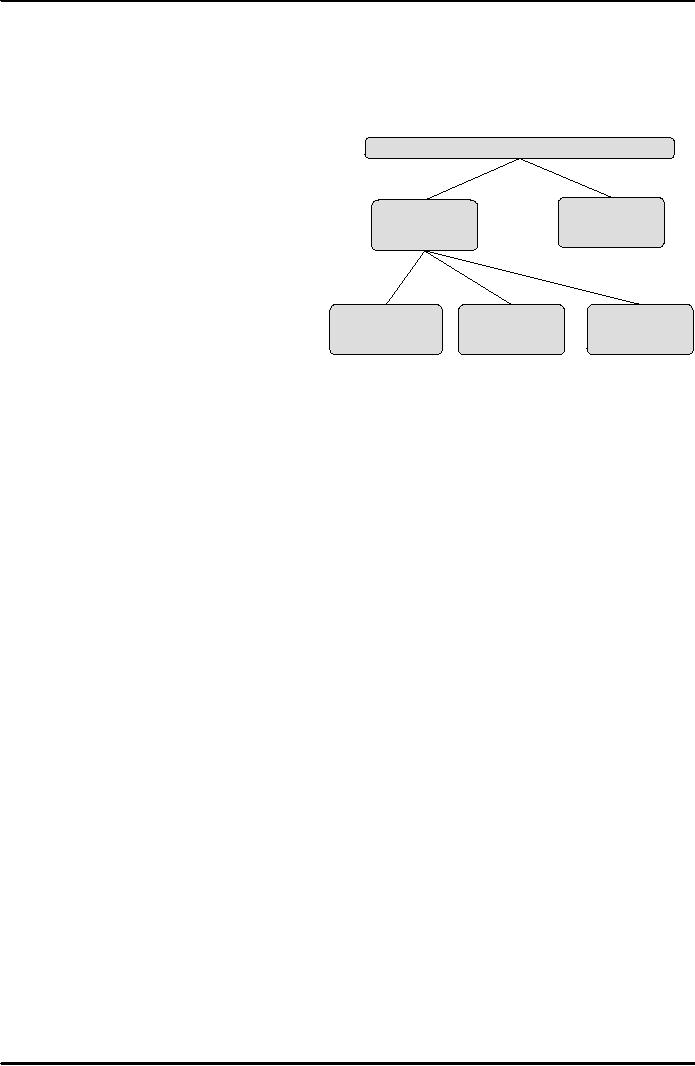 |

Introduction
to Psychology PSY101
VU
Lesson
12
NERVOUS
SYSTEM (1)
Central
Nervous System (CNS) and
Peripheral Nervous System
(PNS)
The
brain and its constituent
parts are the most complex
system ever known. With
one trillion separate
cells,
each one in a continuous process of
changing in response to chemical
signals. From the moment of
conception
to the moment of death, the biology of the
individual is changing. It is in this
complexity that
our
species has found the capability to
store the accumulated experience of
thousands of generations to
create
human culture. Our language, religions,
governments, childrearing practices,
technologies, economies
are
all man-made; yet all
depend upon the remarkable
capacity of the brain to make
internal representations
of
the external world.
Biological
Bases of Behavior
�
The
Nervous System
�
Endocrine
Glands
The
Nervous system
�
The
system that controls and
regulates the structure and
function of the brain, spinal
cord,
nerves,
and the nerve cells; it
maintains coordination between the
nervous system and the
rest
of
the bodily systems.
�
It
is responsible for the internal
communication system that ensures the
integrated functioning
of
the various systems.
Some
Interesting Facts about the
Nervous system
�
The
nervous system consists of
billions of highly specialized
nerve cells called
neurons.
�
Nerve
impulse is an electrical impulse
that travels along the nerves at a
speed of around
400km/
hour.
�
Every
second, a number of these impulses
can pass along
nerves.
�
Brain
cells never re grow; once
destroyed or dead, they can
not be replaced.
�
Nerve
fibers are very thin and
fine in size; a hundred of them
lying side by side would
fit into
just
1mm.
�
The
brain is divided into two
visible parts or hemispheres; the left
hemisphere controls the
right
side of the body, and the
right controls the left
side.
�
The
total surface area of the
cerebral cortex is approximately 2.5sq.ft. if
you spread it flat.
Neuron
A
nervous system cell is constituted
in
Nucleus
such
a way that it is specialized in
receiving,
processing,
and/or
transmitting
Dendrites
information
to other cells.
Cytoplasm
Structure
of a Neuron
�
Dendrites:
Receivers
of incoming
signals;
branch fibers extending
Myelin
Sheath
Soma
outward
from the cell body.
�
Soma:
The
cell body containing
Axon
the
cytoplasm and the nucleus
of
(transmitting
end)
the
cell; cytoplasm keeps it
alive.
Terminal
Buttons
�
Axon:
The
nerve impulses travel
from
the soma to the terminal buttons through
the extended fiber of a neuron
i.e., axon.
71

Introduction
to Psychology PSY101
VU
�
Terminal
Buttons: Swollen,
bulblike structures at one
end of the axon; the neuron
stimulates
the
nearby glands, muscles, or
other neurons
Connection
between nerve cells
�
Synapse:
the
gap between one neuron
and the other.
�
Synaptic
Transmission: the
procedure through which
information is relayed from
one
neuron
to another across the synaptic
gap.
�
Neurotransmitters:
The
post synaptic neuron is
stimulated by the chemical messages
released
from
neurons; they cross the synapse
from one neuron to
another.
The
Chemical Messages
�
The
neurons follow an all-or-none
law.... either a neuron will be
firing or resting
/off.
�
Excitatory
Message: The
chemical message that makes
it more likely that the
receiving
neuron
will fire and the action
potential will travel down
its axon.
�
Inhibitory
Message: The
chemical message that
inhibits a receiving neuron from
firing so
that
the action potential does not travel
down its axon.
Major
Varieties of Neurons
�
Sensory
Neurons (afferent): they
carry messages toward the Central
Nervous System from
the
sensory receptor
cells.
�
Motor
Neurons (efferent): they
carry messages away from the
Central Nervous System
toward
the muscles and
glands.
�
Inter-Neurons:
they
relay messages from sensory
neurons to other inter-neurons and/or
to
motor
neurons.
Main
Parts of the Nervous System
�
The
Peripheral Nervous System
�
The
Central Nervous System
Divisions
of The Nervous
System
Central
Nervous System
Brain
Spinal
Cord
The
Peripheral Nervous System
(PNS)
�
The
part of the
Peripheral
Nervous System
nervous
system that
Sensory
Neurons
Motor
Neurons
includes
all parts of
(afferent)
(efferent)
the
nervous system
except
the brain and the
spinal
cord
Somatic
Division
Autonomic
Division
�
Includes:
(motor
nerves to skeletal
(motor
nerves to glands,
i.
Somatic
muscles)
Smooth
& cardiac muscles
Division
/
Somatic
Nervous
System/
SNS
Sympathetic
Parasympathetic
ii.
Autonomic division /
Autonomic
Nervous
System
Nervous
System
Nervous
System/ ANS
Somatic
Division: controls the
voluntary movements of the skeletal
muscles.
Autonomic
division: controls the
involuntary movements all
over the body; movements of the
heart,
lungs,
stomach, glands and other
organs.
72

Introduction
to Psychology PSY101
VU
Central
Nervous System (CNS)
�
Brain
receives the information from
all over the body (primarily
in terms of stimulation via
sensation),
interprets it, and decides
how to respond.
�
The
brain's function is similar to
that of a computer; there is a central
processing unit (CPU),
the
output comes in, and the
CPU analyses it and responds
to it.
CENTRAL
NERVOUS SYSTEM
The
Brain
�
The
center of the nervous
system.
�
The
vital organ that is
responsible for the
Spinal
Cord
Brain
functions
of seeing, hearing,
smelling,
tasting,
thinking, feeling, remembering,
speaking,
dreaming, information
processing,
and
a lot more.
�
The
regulator of basic survival
functions
such as breathing, resting
FORE
BRAIN
MID
BRAIN
HIND
BRAIN
and
feeding.
�
It
is responsible for abstract
level
functions
such as decision making, foresight,
and problem solving.
�
The
spinal cord is an information highway connecting the
PNS to the brain.
�
Information
travels to and from the
brain by way of spinal
cord.
Functions
of the Various Structures of the
Brain
�
Regulation
of the internal systems
�
Reproduction
�
Sensation
�
Motion
�
Adaptation
to the varying environmental
demands
Structure
of Brain
�
The
deeply grooved structure lies
safely and securely in our
skull.
�
The
average adult human brain
weighs 1.3 to 1.4 kg (approx. 3
pounds).
�
If
you look at it from the
outside the brain is pinkish
gray in color; soft, spongy,
and mottled.
�
The
brain contains billions of
nerve cells (neurons) and
trillions of "support
cells".
Parts
of the Brain
The
brain is made of three main
parts:
a.
Fore brain
b.
Mid brain
c.
Hind brain
Fore
Brain
i.
Cerebrum
ii.
Thalamus
iii.
Hypothalamus
iv.
Limbic system
Mid
Brain
i.
Tectum
ii.
Tegmentum
iii.
Reticular formation
iv.
Substantia nigra
73

Introduction
to Psychology PSY101
VU
Hind
Brain
i.
Cerebellum
ii.
Pons
iii.
Medulla oblongata
Brain
Stem and Cerebellum
Located
underneath the limbic system the brain
stem, containing four
structures, is found in all
vertebrates.
It
contains four
structures:
1.
Medulla
2.
Pons
3.
Reticular
formation
4.
Thalamus
o
Responsible
for basic survival functions
such as breathing, heartbeat, and
blood pressure.
1.
Medulla/
Medulla Oblongata
�
Located
at the top of the spinal cord and
continuous with it.
�
Damage
to Medulla can be fatal as it is the
center responsible for vital
functions i.e.,
respiration,
heart beat, and blood
pressure.
�
Contains
ascending & descending tracts
that communicate between the
spinal cord &
various
parts of the brain.
�
At
medulla, nerves ascending
from the body and descending
from the brain cross
over;
hence
the left side of the body is
connected to the right side of the
brain and vice
versa.
�
Contains
3 vital centers:
Cardio
inhibitory center: regulates
heart rate.
Respiratory
center: regulates
the basic rhythm of breathing.
Vasomotor
center: regulates
the diameter of blood
vessels.
2.
Pons
Pons
= Latin word for
bridge
�
Bridge
connecting spinal cord with brain
and parts of brain with
each other.
�
The
pons seems to serve as a
relay station carrying signals
from various parts of the
cerebral
cortex
to the cerebellum.
�
Nerve
impulses coming from the eyes,
ears and touch receptors
are sent on the
cerebellum.
�
The
pons also participates in the
reflexes that regulate
breathing.
�
It
has parts that are
important for the level of consciousness
and for sleep.
3.
Reticular Formation
�
The
reticular formation is a region running
through the middle of the hindbrain
and into the
midbrain.
�
A
dense network of nerve
cells.
�
It
keeps the brain alert even
during sleep.
�
It
makes the cerebral cortex attend to new
stimulation by arousing
it.
�
Long
fibrous tracts of reticular formation
run into the
thalamus.
�
Needed
for arousal from sleep &
to maintain consciousness.
�
Serious
damage to reticular formation may
result into a coma.
4.
Thalamus
The
pair of egg-shaped structures
located at the top of the
brainstem.
�
Incoming
sensory information is channeled to the
appropriate area of the cerebral cortex
by
thalamus,
so that it is processed
there.
�
Thalamus
acts like a relay
station.... the brain's sensory
switchboard; it directs messages to
the
sensory
receiving areas in the cortex and
transmits replies to the cerebellum
and medulla.
74

Introduction
to Psychology PSY101
VU
�
It
receives information from the
sensory neurons and routes
it to the higher brain regions
that
deal
with vision, audition, taste
and touch.
Cerebellum
�
"Cerebellum"
comes from the Latin word
for "little brain". The
cerebellum is located
behind
the
brain stem.
�
Cerebellum
is somehow similar to the cerebral
cortex: the cerebellum is divided
into
hemispheres
and has a cortex that
surrounds these
hemispheres.
�
It
carries 10% of the weight of the brain.
�
It
contains as many neurons as in the
rest of the brain.
�
Its
function is to coordinate body movements
i.e. coordination, maintenance of
posture &
balance.
�
Damage
to cerebellum results into
jerky and uncoordinated body
movements.
Limbic
System
�
Evolutionarily
the structure of limbic system is rather
old.
�
The
limbic system, often referred to as the
"emotional brain", is found
buried within the
cerebrum.
�
At
the border of the brainstem and
cerebral hemispheres it is a
doughnut-shaped system of
neural
structures;
associated with emotions e.g.
fear and aggression, and
drives like hunger and sex;
regulates
body
temperature, blood sugar level
and blood pressure.
Structures
within the Limbic System
i.
Hippocampus
ii.
Amygdala
iii.
Hypothalamus
Amygdala
�
Two
almond-shaped neural clusters in the
limbic system that are
linked with emotions.
�
They
are related with aggression
and fear.
Hippocampus
�
The
hippocampus is the part of the limbic
system that is important for
memory and learning.
Hypothalamus
�
One of the
smallest structures in the brain.
�
The
neural structure lying below
(hypo) the thalamus; Composed of
several nuclei. Small
bundles
of neurons that regulate physiological
processes involved in motivated
behavior e.g.
hunger,
thirst, regulation of body
temperature.
�
Hypothalamus
acts as the body's Thermostat.
�
Helps
govern the endocrine system via the pituitary
gland.
�
Is
linked to emotions.
Homeostasis
Hypothalamus
maintains the body's internal equilibrium
e.g. looking for food
when energy levels are
low,
causing
constriction of the blood vessels when
body temperature
falls.
Cerebrum
�
Largest
part of the human brain, associated
with higher brain functions
such as thought and
action..
�
Occupies
2/3 of the brain's total
mass
�
Consists
of two symmetrical halves or
hemispheres; The right
cerebral hemisphere controls the
left
side of the body and vice
versa.
�
The
hemispheres are connected by
Corpus Callosum, a thick
mass of nerve fibers.
�
Cerebrum
regulates the brain's higher cognitive
and emotional functions.
75

Introduction
to Psychology PSY101
VU
Cerebral
Cortex
o
Coming
from the Latin word for
"bark", cortex means covering, or sheath;
the cortex is a sheet of
tissue
making up the outer layer of the
brain.
o
About
1/10 of an inch in thickness, the cortex
is composed of some 30 billion
nerve cells and
300
trillion
synaptic connections.
o
It is the
body's ultimate control and information-processing
center.
Sulci
and Gyrus
o
The
cerebral cortex is greatly convoluted in
humans. These convolutions
include:
1.
Sulci (singular
Sulcus) i.e.
small grooves.
2.
Gyri (singular Gyrus)
i.e.
large grooves also called
"Fissures".
Grey
matter
�
Cerebral
cortex mostly consists of glia (glial
cells), cell bodies,
dendrites and
interconnecting
neurons; they give the cerebral cortex a
grayish brown
appearance,
commonly
known as `Grey
Matter".
White
Matter
�
Beneath
the cerebral cortex lie millions of
axons that connect the
neurons of the cerebral
cortex
to those located elsewhere in the
brain.
�
The
large myelin gives tissue an
opaque white appearance
known as "White
Matter".
Cerebral
Lobes
a.
Frontal lobe
b.
Parietal lobe
c.
Temporal lobe
d.
Occipital lobe
�
Each
lobe controls a different range of
activities.
�
Each
hemisphere is vertically divided by the
central
sulcus, a
groove.
�
The
lateral fissure, another groove divides
each hemisphere
horizontally.
a.
Frontal lobe
Associated
with motor control and
cognitive activities; reasoning,
planning, decision making,
problem
solving,
movement and speech (Broca's
Area).
b.
Parietal lobe
Associated
with controlling incoming
sensory information; thus affecting
movement, orientation,
recognition,
perception of stimuli.
c.
Temporal lobe
Associated
with perception and recognition of
auditory stimuli, memory &
speech.
Wernicke's
area: concerned with the understanding of
language is located
here
d.
Occipital lobe
Associated
with visual
processing.
Cranium
o
The
brain is enclosed in the cavity of skull
or cranium consisting of eight hard
bones; One frontal
bone,
two parietal bones, two temporal
bones, one occipital bone, one sphenoid
bone, and one
ethmoid
bone.
76
Table of Contents:
- WHAT IS PSYCHOLOGY?:Theoretical perspectives of psychology
- HISTORICAL ROOTS OF MODERN PSYCHOLOGY:HIPPOCRATES, PLATO
- SCHOOLS OF THOUGHT:Biological Approach, Psychodynamic Approach
- PERSPECTIVE/MODEL/APPROACH:Narcosis, Chemotherapy
- THE PSYCHODYNAMIC APPROACH/ MODEL:Psychic Determinism, Preconscious
- BEHAVIORAL APPROACH:Behaviorist Analysis, Basic Terminology, Basic Terminology
- THE HUMANISTIC APPROACH AND THE COGNITIVE APPROACH:Rogers’ Approach
- RESEARCH METHODS IN PSYCHOLOGY (I):Scientific Nature of Psychology
- RESEARCH METHODS IN PSYCHOLOGY (II):Experimental Research
- PHYSICAL DEVELOPMENT AND NATURE NURTURE ISSUE:Nature versus Nurture
- COGNITIVE DEVELOPMENT:Socio- Cultural Factor, The Individual and the Group
- NERVOUS SYSTEM (1):Biological Bases of Behavior, Terminal Buttons
- NERVOUS SYSTEM (2):Membranes of the Brain, Association Areas, Spinal Cord
- ENDOCRINE SYSTEM:Pineal Gland, Pituitary Gland, Dwarfism
- SENSATION:The Human Eye, Cornea, Sclera, Pupil, Iris, Lens
- HEARING (AUDITION) AND BALANCE:The Outer Ear, Auditory Canal
- PERCEPTION I:Max Wertheimer, Figure and Ground, Law of Closure
- PERCEPTION II:Depth Perception, Relative Height, Linear Perspective
- ALTERED STATES OF CONSCIOUSNESS:Electroencephalogram, Hypnosis
- LEARNING:Motor Learning, Problem Solving, Basic Terminology, Conditioning
- OPERANT CONDITIONING:Negative Rein forcer, Punishment, No reinforcement
- COGNITIVE APPROACH:Approach to Learning, Observational Learning
- MEMORY I:Functions of Memory, Encoding and Recoding, Retrieval
- MEMORY II:Long-Term Memory, Declarative Memory, Procedural Memory
- MEMORY III:Memory Disorders/Dysfunctions, Amnesia, Dementia
- SECONDARY/ LEARNT/ PSYCHOLOGICAL MOTIVES:Curiosity, Need for affiliation
- EMOTIONS I:Defining Emotions, Behavioral component, Cognitive component
- EMOTIONS II:Respiratory Changes, Pupillometrics, Glandular Responses
- COGNITION AND THINKING:Cognitive Psychology, Mental Images, Concepts
- THINKING, REASONING, PROBLEM- SOLVING AND CREATIVITY:Mental shortcuts
- PERSONALITY I:Definition of Personality, Theories of Personality
- PERSONALITY II:Surface traits, Source Traits, For learning theorists, Albert Bandura
- PERSONALITY III:Assessment of Personality, Interview, Behavioral Assessment
- INTELLIGENCE:The History of Measurement of Intelligence, Later Revisions
- PSYCHOPATHOLOGY:Plato, Aristotle, Asclepiades, In The Middle Ages
- ABNORMAL BEHAVIOR I:Medical Perspective, Psychodynamic Perspective
- ABNORMAL BEHAVIOR II:Hypochondriasis, Conversion Disorders, Causes include
- PSYCHOTHERAPY I:Psychotherapeutic Orientations, Clinical Psychologists
- PSYCHOTHERAPY II:Behavior Modification, Shaping, Humanistic Therapies
- POPULAR AREAS OF PSYCHOLOGY:ABC MODEL, Factors affecting attitude change
- HEALTH PSYCHOLOGY:Understanding Health, Observational Learning
- INDUSTRIAL/ORGANIZATIONAL PSYCHOLOGY:‘Hard’ Criteria and ‘Soft’ Criteria
- CONSUMER PSYCHOLOGY:Focus of Interest, Consumer Psychologist
- SPORT PSYCHOLOGY:Some Research Findings, Arousal level
- FORENSIC PSYCHOLOGY:Origin and History of Forensic Psychology